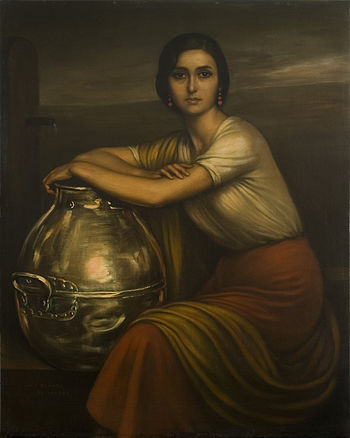Talk:La Fuensanta
| This article is rated Start-class on Wikipedia's content assessment scale. It is of interest to the following WikiProjects: | ||||||||||||||||||||||||||||
| ||||||||||||||||||||||||||||
Spanish Naming Conventions[edit]
Would not this lady’s name be referred to as López González (as one term) rather than simply as González? 67.160.77.95 (talk) 11:19, 6 October 2022 (UTC)
- Either López or López Gonzalez. González is NOT a last name, it is a second, less important, surname. Second surnames are only more used if the first surname is much more common, as in José Luis Rodríguez Zapatero, or Pablo Ruiz Picasso. 83.236.183.138 (talk) 08:46, 9 May 2023 (UTC)
Featured picture scheduled for POTD[edit]
Hello! This is to let editors know that File:La Fuensanta,_by_Julio_Romero_de_Torres.jpg, a featured picture used in this article, has been selected as the English Wikipedia's picture of the day (POTD) for May 9, 2023. A preview of the POTD is displayed below and can be edited at Template:POTD/2023-05-09. For the greater benefit of readers, any potential improvements or maintenance that could benefit the quality of this article should be done before its scheduled appearance on the Main Page. If you have any concerns, please place a message at Wikipedia talk:Picture of the day. Thank you! — Amakuru (talk) 07:36, 2 May 2023 (UTC)

|
La Fuensanta is a portrait painting by Spanish artist Julio Romero de Torres depicting Maria Teresa López González, one of his models. The painting was made in the autumn of 1929, when Torres completed another two artworks, La Chiquita Piconera and Bodegas Cruz Conde. González was one of Torres's favourite models, having first sat for him at the age of fourteen. According to Sotheby's, the work has been "proclaimed as a quintessential rendition of Andalucian beauty", and it was depicted for 25 years on the 100 peseta banknote. The work was exhibited at the Ibero-American Exposition in Seville in 1930, and is now in a private collection. Painting credit: Julio Romero de Torres
Recently featured:
|
What does "Fuensanta" mean?[edit]
It would be helpful for non-Spanish speakers if the article explained what "Fuensanta" means, please? Mr Serjeant Buzfuz (talk) 01:58, 9 May 2023 (UTC)
- Thanks for adding the explanation. I thought "santa" would mean something holy or saint-related. Enjoyed reading the article. It is a very striking painting. Mr Serjeant Buzfuz (talk) 03:13, 9 May 2023 (UTC)
- Start-Class visual arts articles
- WikiProject Visual arts articles
- Start-Class Spain articles
- Unknown-importance Spain articles
- All WikiProject Spain pages
- Start-Class Women's History articles
- Unknown-importance Women's History articles
- All WikiProject Women-related pages
- WikiProject Women's History articles


